Last updated on January 6, 2022
Content By: Dr. Nikita Toshi BDS, Assistant Manager (Medical Review), Dr. Ritu Budania MBBS, MD (Pharmacology) Head, Medical Affairs
Last updated on January 6, 2022
All across the globe, doctors are prescribing exercises for heart patients and people with diabetes to help manage their conditions. With the right exercise regimen, it is possible to strengthen your heart and do away with a number of risk factors for both diabetes and heart disease.
The habit of exercise is something that all of us want on some level but it can be so difficult to build. Luckily, there are a lot of different things you can try now to give yourself a better chance of creating an exercise routine. The important thing is to start trying and keep trying until you succeed.
One important point to be remembered for a heart patient is to choose the right type of exercise after discussion with your doctor.
Read on to find out more about exercises that can help you lead a healthier life.
All across the globe, doctors are prescribing exercises for heart patients and people with diabetes to help manage their conditions. With the right exercise regimen, it is possible to strengthen your heart and do away with a number of risk factors for both diabetes and heart disease.
The habit of exercise is something that all of us want on some level but it can be so difficult to build. Luckily, there are a lot of different things you can try now to give yourself a better chance of creating an exercise routine. The important thing is to start trying and keep trying until you succeed.
One important point to be remembered for a heart patient is to choose the right type of exercise after discussion with your doctor.
Read on to find out more about exercises that can help you lead a healthier life.

Written by
BDS, Assistant Manager (Medical Review)

Reviewed by
MBBS, MD (Pharmacology) Head, Medical Affairs
To start improving your heart health and lowering your risk of heart disease, the first two things you will need to think about are diet and exercise for heart patients. These are two game-changing factors that are reasonably in your control and they can make all the difference to your heart.
Let’s look at some of the major risk factors for heart disease.
Obesity – Together, diet and exercise take on obesity, which is also a significant risk factor for type 2 diabetes.
Lack of physical activity (sedentary lifestyle) – The World Health Organization (WHO) recommends 150 minutes of exercise every week for all adults. Exercises can be crafted with doctors advice according to the patient’s requirements and can help overall strengthen the cardiovascular system and boost general health.
Unhealthy diet – Deep fried, sugary and processed food can lead to a rise in blood sugars, cholesterol and buildup of plaque in the arteries, (atherosclerosis). Eating whole foods with more fibre content and cutting down on processed foods can help in atherosclerosis prevention.
Stress – Stress can cause an increase in your blood pressure, which puts a strain on your heart. Finding healthy ways to cope with stress, like sport, music and other hobbies can relieve stress very effectively. If you are unable to cope with your stress by yourself, consider contacting a mental health professional to help you manage your stress.
Regular Smoking and Drinking – Smoking and consuming alcohol are two habits that have a profound impact on your heart health over the long term. Alcohol contributes to atherosclerosis and combined with smoking, it can increase the risk of many complications.
The phrase, movement is medicine is growing in popularity as the scientific community and fitness enthusiasts continue to observe the number of different ways exercises can improve our health and life. Exercising has many different benefits for different functions of the body.
Helps you lose excess fat and weight – As a key activity in combating obesity, exercise can significantly help reduce the risks of heart disease by helping you lose excess fat and weight.
Helps bring down blood pressure, cholesterol and sugar levels – Research has also shown that exercises for heart patients can lower blood pressure, improve the balance of cholesterol levels and blood sugar. Exercise also strengthens the heart by encouraging the arteries to dilate, thereby improving blood flow.
Reduces the risk of heart surgery – A study in 2013 observed that increased physical activity was able to reduce coronary heart disease events by 29% in women and 21% in men. Research also indicates that people with better exercise habits are less likely to need bypass surgery or angioplasty.
Strengthening the heart muscle – Athletes are a great example of how exercise can help the heart work more efficiently. Usain Bolt and Mo Farah are two famous examples with a resting heart rate below 40. When we exercise, we are also exercising the heart, training it to pump more blood with greater efficiency.
Helps improve mental health – Exercise leads to a boost in endorphin production, which is associated with better mood as well as reduced anxiety and stress. Your energy levels also improve when you exercise. According to a study that monitored 36 people over six weeks, exercise helped people with symptoms of persistent fatigue feel less tired on a day-to-day basis.
Reduces your risk of diabetes – Your body’s insulin sensitivity is increased when you exercise, counteracting insulin resistance, which is the cause of type 2 diabetes and uncontrollable sugar levels. It also reduces your belly fat or visceral fat over time, which reduces your risk of lifestyle diseases like diabetes and cardiovascular disease.
Helps improve brain function – Exercise also improves the way your brain functions, especially as you grow older. The increased blood flow and the hormones produced during exercise positively affect our brains in many ways. Research has shown that the hippocampus (a part of the brain) can actually grow in size when you exercise regularly.
Strengthens your bones, muscles and joints – Your muscles and bones get stronger when you exercise regularly, making your body tougher and able to perform regular physical activity more easily.
Improves general quality of life – Studies have shown that exercise provides relief and improves the quality of life for people who experience chronic pain. Exercise also leads to improved pain tolerance and decreased pain perception. Exercise has also been shown to boost the quality of sleep and general recovery from pain and weakness.
According to WHO, people with insufficient physical activity are at an increased risk of death at an early age compared to people who exercise regularly. The risk is increased by as much as 30%.
WHO also estimates that up to 5 million deaths a year can be avoided if exercise becomes a part of everyone’s everyday routines.
Getting a decent amount of exercise for heart health can improve your condition dramatically. Even among heart patients who have undergone bypass surgery and angioplasty, exercise is still an important countermeasure. However, it needs to be performed under expert supervision only after the advice of your doctor.
Exercise is good for everyone but make sure you start slow and gradually build up. It is important to give your heart time to acclimatize to the body’s demands, especially after a coronary incident.
Cardiac rehabilitation is a session of medically supervised exercises for heart patients that are recommended 2 – 3 times a week for around 3 months when recovering from a heart attack or surgery.
When it comes to exercise, the difference between someone with a healthy heart and a heart patient is how much they can push themselves. A healthy person can progress rather quickly with their exercise routines whereas someone with a heart problem should take it slow and build themselves up over a longer period of time. This is simply due to the ability of the heart to handle the pressure.
Sudden increases in blood pressure and reaching maximum heart rate can be too much to handle for an already burdened cardiovascular system. Exercises like weightlifting, HIIT and CrossFit are intense kinds of exercises and should be avoided. If needed should be attempted only after consulting a doctor.

Manage the symptoms of heart disease with the right medicines!
Order online on PharmEasy and get it home delivered at your convenience!
The most important thing about adopting a new exercise routine is to start with the right exercise for heart patients and adjust the intensity as you go. You can increase the duration or difficulty of the exercise as you get used to it but it’s recommended always to do so gradually.
A surge in heart rate or blood pressure can be dangerous for a heart patient. It is better to understand the type of physical activity that is allowed to you by your doctor. Do slow and easy exercises at first that is measured in time instead of repetitions (reps).
If you’re just starting out or if you’ve had an issue with your heart, the best exercises for heart health are probably routine activities like walking or doing work in the house or in the yard. When you start, the important thing is to choose something that is simple, easy and does not require any extra preparation.
Remember not to push yourself too hard. Exercises take time to build into a habit and overstraining yourself is a surefire way to halt your progress.
One of the most popular kinds of exercise for cardiovascular endurance is walking. You can set a timer for 30 minutes and walk around your neighbourhood. Start with casual strolling and work your way up to a brisk, continuous walk as you gain strength. It is a good idea to monitor your walking heart rate with a smartwatch to understand how your body is responding.
After a few days of brisk walking, if you are feeling up to it, try jogging for 20 – 30 seconds if your doctor allows. You will be able to gradually increase the amount of time you can jog but to be on the safer side, increase it slowly by 10 – 15 seconds a week. You can evaluate your improvement by looking at your walking heart rate and comparing it to when you started.
This is another exercise for heart patients that is rapidly gaining popularity in India. If walking or jogging is too mundane for you, cycling can provide that extra excitement while giving you a similar kind of workout.
An advantage cycling has over walking and jogging is the ability to increase and decrease the intensity of your workout at your convenience. This allows you to get rest between intervals of increased intensity.
However, it is important to be extra careful while you are on a cycle since you may not have a dedicated cycling lane or space. If possible, try to find someone to join you when you cycle so that you have support if you need it. In cases where you are unable to cycle outdoors, stationary cycling can also be another option you can consider.
Arguably the best kind of exercise for cardiovascular endurance, swimming gives you everything your body needs. Swimming works your heart and lungs for a stronger cardiovascular system. It also works your entire body, giving you greater overall stamina and strength.
The water is relaxing and fun to be in even when you aren’t swimming, which is why it is one of the most popular exercises. Unlike walking, jogging and cycling, swimming doesn’t place much strain on the joints, so it is better for people who struggle to do normal exercises. Even walking in the water counts as exercise and swimming as whole burns roughly as many calories as running.
For heart patients, the sports they can try depend on their fitness level. For someone who does not exercise much, overexertion can be dangerous. However, for someone who regularly exercises, periods of increased intensity are easier to deal with.
Here are some sports to consider.
Badminton – A simple 1v1 or 2v2 sport you can play casually and where you can choose how active to be at any given moment.
Tennis – It is easy to play casually since it is a 1v1 or 2v2 sport, similar to badminton.
Volleyball – It involves holding a position that gives you control over how much you exert yourself.
Table tennis – Since it is a 1v1 or 2v2 game, you can play casually without pressure from other players and slowly develop your fitness and skills over time.
Football, basketball and hockey are highly competitive sports where you are likely to instinctively overexert yourself to support your team. Until you have reached a level of fitness and heart health that supports your body in these games, you should work on simpler exercises.
Not all exercises are about getting from one place to another. Yoga is something you can do in a single spot, by yourself with just a yoga mat or bedsheet. Like other forms of exercise, yoga also works on your cardiovascular system while improving your muscle strength, bone strength and flexibility. There are several yoga exercises that help you boost your blood circulation such as:
![]() Surya Namaskar
Surya Namaskar
![]() Sukhasana ( Easy Pose)
Sukhasana ( Easy Pose)
![]() Uttanasana (Standing forward bend)
Uttanasana (Standing forward bend)
![]() Tadasana (Mountain Pose)
Tadasana (Mountain Pose)
![]() Padangusthasana (Big Toe Pose)
Padangusthasana (Big Toe Pose)
We will touch more upon yoga asanas for heart patients in section 4 of this article.
One of the best ways to cope with stress and anxiety is to meditate and focus on your breathing. Guided breathing and meditation induce a state of relaxation that is capable of calming your nerves and reducing blood pressure.
Cytokines are inflammatory chemicals released in your body when you are stressed. Meditation and breathing exercises have been observed to reduce this inflammation caused by stress.

Boost your exercise and diet plans with the right supplements.
Order online on PharmEasy and get great discounts in just a few clicks!
Working on your physical fitness is an important step to heart health but there are risks of overdoing it. You should try to avoid any exercise that leads to maximum heart rate. Reaching maximum heart rate can cause pain in the chest, also known as angina.
Always discuss the exercises allowed to you with your doctor before doing it.
High-intensity training regimens of strength training and weight lifting require a lot of energy and this means your heart has to constantly fuel up the muscles with oxygen. In some cases, intensive strength or weight training can lead to chest pain and other cardiovascular complications.
If performed in low to moderate amounts, both weight lifting and strength training carry the positives of exercises when it comes to better cardiovascular performance, weight loss, insulin sensitivity, muscle quality and bone strength.
For heart patients, it is recommended to consult the doctor first and use lighter weights and to avoid pushing too hard to improve strength even if allowed. Typically, the limit on the weights should be about half of what a healthy person with a normal cardiovascular system would do. It is also good to keep an eye on your heart rate during exercise.
If you’re worried about your heart when you are resistance training, here are some useful tips you can follow:
Slow, controlled movements and a steady rhythm are important.
Don’t stop your breathing while you work out. Keep a constant rhythm of inhalation and exhalation to make sure you are getting enough oxygen.
Don’t overwork any muscle group. Try to alternate between the lower body and upper body when you work out.
When you start, don’t do more than 2 sets per exercise and restrict yourself to 2 – 3 exercises for the entire workout.
Start with 10 – 15 repetitions per set and use light weights. You should be able to do 2 – 3 sets comfortably with whatever weight you use. If you start to feel tired after the first 8 repetitions, reduce the weight.
Consider using resistance bands instead of weights. It is easier to gauge your strength and endurance, making it safer for you to work out.
Give yourself plenty of recovery time between training days and do some brisk walking or cycling instead.
Here are some exercises you can include in your workouts if allowed by your doctor.
![]() Chest press
Chest press
![]() Shoulder press
Shoulder press
![]() Bicep curl
Bicep curl
![]() Tricep extension
Tricep extension
![]() Leg press
Leg press
![]() Leg curl
Leg curl
![]() Calf raise
Calf raise
![]() Pull-down (Lat exercise)
Pull-down (Lat exercise)
![]() Squats
Squats
![]() Assisted Pull-ups
Assisted Pull-ups
![]() Half push-ups
Half push-ups
Try to have 2 – 3 sessions a week and make sure to switch out muscle groups often. For example,
Day 1: Chest & Triceps
Day 2: Back & Biceps
Day 3: Legs
Day 4: Shoulders & Abs
Day 5: Cardio
You can do light abdominal workouts anytime but do not strain yourself. A 15 – 20 second plank to end every workout should be a good starting place.
If you want to try an exercise that’s not on the above list, that’s okay but make sure you start at a lower difficulty level with reduced weights and repetitions until you are fully comfortable with the exercise. Check your heart rate after exercise so you can monitor your progress.
Calcification of the coronary arteries or atherosclerosis is one of the warning signs of cardiovascular disease. According to a study by Mayo clinic proceedings, people who exercised 3 times more than the recommended amount per week showed higher levels of calcification in their coronary arteries. The calcified material on the inside of your artery can break away and cause problems for the heart.
Therefore, going to extremes with any kind of exercise is bad for your heart, especially if you have a history of cardiovascular disease. How to know if you’re exercising excessively? Here are some consequences to look out for:
![]() Constant fatigue
Constant fatigue
![]() Increased risk and occurrence of injuries
Increased risk and occurrence of injuries
![]() Difficulty sleeping
Difficulty sleeping
![]() Excess Cortisol - Cortisol is a hormone released when you are under stress. Unchecked cortisol levels can impair your metabolism and lead to weight gain, increased blood pressure and cravings for unhealthy food.
Excess Cortisol - Cortisol is a hormone released when you are under stress. Unchecked cortisol levels can impair your metabolism and lead to weight gain, increased blood pressure and cravings for unhealthy food.
![]() Mood swings and lack of emotional control
Mood swings and lack of emotional control
Push-ups and sit-ups are exercises that you can do without any equipment and together they give you a fairly complete workout. They build muscle and raise your heart rate during exercise. The increase in muscle gives you a higher resting metabolic rate, which means that your body consumes more energy when it is at rest.
Push-ups and sit-ups are heart strengthening exercises that give you a stronger cardiovascular system and more balanced cholesterol levels. Your blood circulation improves, which can have a positive impact on your blood pressure, which is a vital measure of heart health. Studies have shown that if you can do 11 pushups continuously, your risk of heart disease goes down by a whopping 68%.
If it seems difficult at first, maybe start with half push-ups and half sit-ups to make it easier. Don’t overwork yourself. If all you can do is 2 sets of 5 each, that’s okay. The key is to let your body understand the demands you are putting on it so that you can improve over a period of time.
Exercise for cardiovascular endurance is a key part of the recovery process. However, different situations call for different responses in terms of the type and intensity of the exercise.
It is important to assess your capacity for exercise under the supervision of a cardiologist. In some cases, your doctor may advise you not to exert or exercise at all. One must exercise only after discussing about the right exercise suitable for your body from a doctor. This way, you can exercise safely without risking damage to your cardiovascular system.
Here are some general guidelines for choosing exercises:
Choose exercises where you can control the difficulty more easily.
Examples – Dumbell workouts (reduced weights), half push-ups, chest/shoulder press, swimming, walking or cycling.
Choose exercises where you can breathe in and out comfortably without having to hold your breath. Keeping a steady flow of air is important to avoid straining your cardiovascular system.
Make sure you choose a list of exercises that allow you to alternate between the upper body and lower body to avoid muscle fatigue from building up.

The right medicines can help in managing your heart disease better.
Order online on PharmEasy today and get them home delivered at your convenience!
Yoga is definitely a contender for the title of the best exercise for heart health. There are several yoga asanas that are associated with improved blood circulation, increased metabolism and bring you closer to your target heart rate.
The best thing about yoga is you need nothing other than a mat to help you get a foothold on the ground. It is a simple form of exercise with tremendous benefits for your health.
The combination of exercise, meditation and controlled breathing addresses all the physical training aspects related to heart health. Studies have found that yoga can reduce the secretion of cortisol, a hormone that the body produces when we are stressed. High levels of cortisol are an indication of cardiovascular issues.
Some studies have also linked yoga with a decrease in inflammation. Inflammation promotes plaque buildup in the arteries, also known as atherosclerosis. Atherosclerosis causes an increase in blood pressure and a risk of clots making their way to the heart. According to a study of 113 participants, yoga and diet helped reduce bad cholesterol (also known as LDL cholesterol) by 26%.
Yoga can also help improve one’s quality of sleep, which is important to maintain well being and heart health. Studies have also shown that yoga improves your breathing and lung capacity, which makes it easier for your heart to oxygenate the blood in the body.
Known as a sun salutation in the west, the Surya Namaskar is one of the most popular exercises. It follows a cycle of 12 steps with a breathing rhythm. Together, all the steps and poses work on multiple muscle groups at the same time.
Here are some of the benefits of the Surya Namaskar
![]() Increased strength
Increased strength
![]() Better hormonal balance
Better hormonal balance
![]() Weight loss
Weight loss
![]() Increased joint strength
Increased joint strength
![]() Improved sleep
Improved sleep
![]() Works out the cardiovascular system
Works out the cardiovascular system
![]() Improved breathing control
Improved breathing control
This exercise was made to be performed in the morning on an empty stomach as the sun comes up. The reason behind this is that your metabolism works better in a fasted state, offering benefits when it comes to weight loss and better energy levels.
However, like any exercise, the best time to do a Surya Namaskar is the time that suits your schedule. Doing it consistently over a long period of time is what gives you the benefits of the exercise. Just make sure you haven’t eaten a meal at least 3 – 4 hours prior to doing Surya Namaskar.
There are several other yoga asanas that can boost heart health. Here are some you can try out.
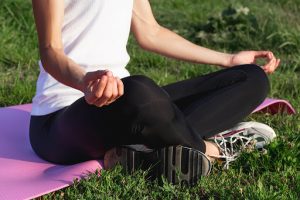
The easy pose is, as the name suggests, easy to do. Here’s a step by step guide on how to do a proper sukhasana.
When doing this pose, it is important you are breathing deeply with controlled breaths.
Your spine gets a good stretch and you strengthen your back muscles.
This easy and relaxing asana will calm your mind and help you breathe easily, reducing stress and anxiety which can harm your heart and help you reach your target heart rate.
It works out the hips, which are often under-exercised for most people.
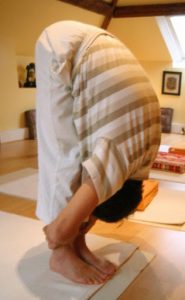
While it looks simple, the Uttanasana is a stretching pose that can be quite intense when you get it right. When you do this exercise, your calves and hamstrings will be at full stretch. Take your time to get used to it.
The inversion of the upper half of the body promotes improved blood circulation, especially to the brain.
This pose relieves stress and lowers blood pressure for a healthier heart.
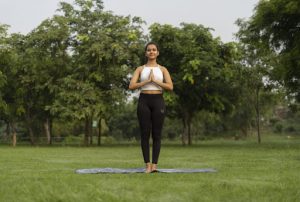
Stand tall like a mountain in Tadasana. This is a foundational pose for many different yoga asanas and is easy to do.
Improves blood circulation in the body, making it easier for the heart to do its job.
The heart benefits from the strengthening of muscles from this asana and you can use it to achieve your target heart rate.
This asana improves posture and coordination, allowing you to progress further in your exercise routines.
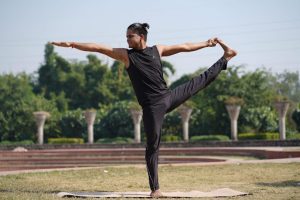
Don’t overdo it, since you can get injured from this exercise when you push yourself too hard. You can try doing it while lying down first, in order to train your muscles a bit first.
This asana expands the chest and improves blood circulation, both of which are good for the heart.
The asana improves balance and strength, which boosts your potential for further exercise.
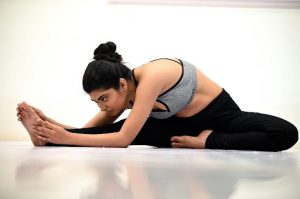
Focus on keeping your chest above your thigh and not on your head touching your knee. Keep the spine straight for as long as possible before you allow it to bend.
The stretching in this asana helps to recover from fatigue and muscle strain. This asana is really good if your exercise routine has more cardio in it.
Through controlled breathing and good stretches, you will find your anxiety and stress is easier to manage through this asana.
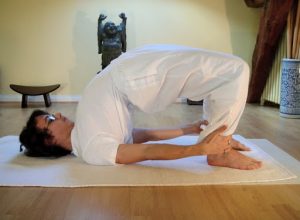
This asana provides relief from stress and gives you clarity of mind, which makes it one of the better exercises.
By stretching the entire spine and the lower body, this asana promotes improved blood circulation and strength. It is a great way to recover from fatigue and to prevent lower back problems.

Supplement your yoga routine with the right nutritional supplements.
Order them at PharmEasy today!
One aspect of our health that is largely underemphasized is our breathing. Breathing well can have healing and therapeutic properties. Pranayama, which stems from the Sanskrit words “Prana” which means life energy and “Yama” which means control. The practice of pranayama is an effort to control some body functions using breathing.
Here are some of the benefits of pranayama for your heart:
By reducing the secretion of cortisol in the body, pranayama and meditation help combat stress.
Mindful breathing has been observed to have a positive impact on people with high blood pressure.
Pranayama has been associated with improved quality of sleep. Getting enough sleep reduces heart risk significantly.
You can perform pranayama to bring down your heart rate after exercise.
Pranayama strengthens the lungs and allows you to take in more air and therefore, oxygen for your heart to pump into the blood.
Smokers can turn to pranayama to help control cigarette cravings and combat the withdrawal symptoms when they quit or reduce their smoking.
Anulom Vilom Deep Breathing – This pranayama involves breathing in through one nostril and breathing out through the other nostril using your thumb and ring fingers to press on either nostril during the process. This is done while seated in a cross-legged position and helps in improving respiratory function as well as purifying the blood in turn.
Sheetali Purak – This is known as the cooling breath and is performed by inhaling and exhaling through the mouth while having your tongue in a rolled position. This pranayama can be performed by sitting in a cross-legged position. Sheetali Purak has been shown to help lower blood pressure and calm the mind and body, relieving it from stress.
Ujjayi Pranayama – This is known as the victorious breath and is performed by inhaling and expelling air through the nostrils but with a slightly constricted throat – like you would be when you want to whisper. Focus on breathing through the throat muscles and expanding your lungs and abdomen as you inhale. As you exhale, focus on expelling air through a slightly constricted throat but not too much that it sounds like a baby’s snore. The Ujjayi pranayama, if performed correctly, has been shown to help reduce stress, blood pressure and the risks of heart problems.
Bhramari Pranayama – This is known as the humming bee breath and can also be performed in a cross-legged position. This pranayama involves inhaling through your nostrils and producing an “mmm” sound through pursed lips as you exhale and expel all the inhaled air slowly. Focus on your breathing and moreover the sound as it should be even, controlled and smooth. Research has shown that the Bhramari pranayama can help relieve tension, lower blood pressure, stimulate the healing of body tissue especially after surgeries and overall improve heart health if performed regularly and correctly.
Kapalbhati – This pranayama involves one taking a deep inhale through the nostrils and exhaling the air through the nostrils in short and sharp bursts while contracting the abdomen muscles in intervals until all the inhaled air is expelled completely. Kapalbhati pranayama can sometimes put stress on the heart hence is not recommended for those dealing with heart problems.
Bhastrika – This pranayama involves the quick and forceful inhalation and exhalation of air through the nostrils powered by the diaphragm to contract in rapid succession. Bhastrika is similar to Kapalbhati and is not recommended for heart patients due to similar negative impacts it can have on the heart if performed incorrectly or excessively.
Agnisar – This pranayama involves one inhaling through the nostrils and rapidly moving the stomach and abdomen muscles from the top to bottom to resemble waves upon exhalation. This pranayama is not recommended for those with heart problems as it involves strict breath control and abdominal movements that can put pressure on the heart.
A mudra is a hand position that is often used with yoga asanas and pranayama breathing.

Manage the symptoms of your heart disease with the right medicines!
Order online on PharmEasy and get it home delivered at your convenience!

Supplement your treatment of your heart disease with the right health care products.
Order online on PharmEasy and get great discounts in just a few clicks!
Exercise has a number of benefits for heart patients but it is important to discuss with your doctor about the right exercise. If done correctly, It may help in reducing your blood pressure, helps you lose weight and combat stress, all of which are risk factors for heart disease. WHO recommends that all adults get at least 150 minutes of exercise every week to combat lifestyle-related health problems like diabetes and cardiovascular disease.
Heart patients should avoid sudden increases in their heart rate during exercise. Chest pain or angina is a common problem faced by heart patients who take up intense exercise before they are ready for it. The key to a healthy exercise regimen is to slowly and gradually increase the intensity of exercise while monitoring your body’s response to it.
Barring certain types of pranayama like Anulom Vilom, Anugeet and certain asanas like Sarvangasana, most yoga practices are good exercises. Like any kind of exercise, it takes a certain amount of practice and skill to do yoga asanas perfectly. Start with the easier ones and gradually work your way up. Take care to avoid asanas where your body is inverted as they can force your heart to work harder. Don’t forget to seek your cardiologists’ advice before starting any physical activity.
150 minutes of exercise is the recommended amount of exercise as prescribed by WHO. Overexercising (more than 300 minutes a week) is linked with many problems and an increased risk of heart disease. On the other hand, an inactive lifestyle is estimated to be a significant cause for a majority of the world’s increasing cases of cardiovascular disease.
Minimally invasive surgery may have faster recovery times but most heart surgeries require the patient to rest for anywhere between 12 – 15 weeks before taking up any kind of exercise other than casual walking. Wait until the doctor gives you the green light before you start exercising.
Exercise is crucial for pregnant mothers with cardiovascular disorders since a healthy mother is more likely to safely deliver a healthy baby. Consult a gynaecologist or a fitness expert who is experienced with exercise during pregnancy to help you build a routine. Exercise also helps combat gestational diabetes in pregnant women.
Swimming is perhaps the best exercise for heart health. It covers everything needed by heart patients. It strengthens the muscles and cardiovascular system without straining the joints. Swimming is a fun activity that burns as many calories as running. The only drawback of swimming is that you need access to a swimming pool.
Avoid playing intense team sports like football, basketball and hockey which require you to push yourself even when you are tired. Sports like badminton, tennis and table tennis are good options where you can take breaks easily without worrying about disappointing your teammates.
Exercises for heart patients should always be done with really light weights before building up to more intense exercise.
For arm workouts like bicep curl and tricep extensions, restrict yourself to a maximum of 5 kg for one hand and 10 kg combined for two hands.
For workouts like lat pull-downs and leg presses that use a larger group of muscles, you can go up to 20 kg but only if you have trained sufficiently to be comfortable with lighter weights first. This depends from person to person and should be discussed with your doctor and trainer first.


Leave a Comment